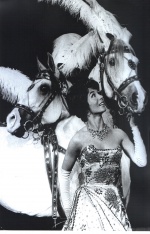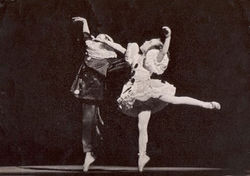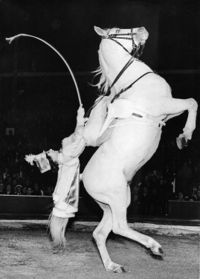Difference between revisions of "Paulina Schumann"
From Circopedia
(→Equestrian Diva) |
|||
| Line 23: | Line 23: | ||
Following the birth of her two sons, Benny (b. 1945) and Jacques (b. 1947), Paulina's father-in-law asked her to present a "liberty" act with six horses, even though she had no equestrian experience. She answered, "I will do it, but I will do it my way." The former acrobat and variety dancer was determined to bring her knowledge of the crafts and aesthetics of variety shows into the far more conservative world of classic equestrian circus. She began by introducing an uncommon sophistication in lighting, costume design, musical arrangements, and thematic presentations, demanding what was, at the time, an unusual amount of financial investment (especially in the costumes). | Following the birth of her two sons, Benny (b. 1945) and Jacques (b. 1947), Paulina's father-in-law asked her to present a "liberty" act with six horses, even though she had no equestrian experience. She answered, "I will do it, but I will do it my way." The former acrobat and variety dancer was determined to bring her knowledge of the crafts and aesthetics of variety shows into the far more conservative world of classic equestrian circus. She began by introducing an uncommon sophistication in lighting, costume design, musical arrangements, and thematic presentations, demanding what was, at the time, an unusual amount of financial investment (especially in the costumes). | ||
| − | In 1947—the year of Paulina's equestrian debut—British producer Tom Arnold and director Clement Butson launched a huge winter circus show at the [[Harringay Circus|Harringay]] Arena in London. The Schumanns, who had previously worked intermittently for [[Bertram Mills | + | In 1947—the year of Paulina's equestrian debut—British producer Tom Arnold and director Clement Butson launched a huge winter circus show at the [[Harringay Circus|Harringay]] Arena in London. The Schumanns, who had previously worked intermittently for [[Bertram Mills Circus]], the other great London winter circus, began an association with Tom Arnold, one that would help them establish their reputation as the world's foremost equestrian family. |
The new producers were impressed by Paulina's ideas and her sense of showmanship. They agreed to invest in her expensive costumes and staging concepts. The results of this financial collaboration could be seen each year in the fully produced, brilliantly themed equestrian acts they presented in the circuses of Stockholm, Göteborg, Copenhagen, and Harringay. Working year-round in a series of circus buildings, with long stands in each, gave Paulina and Albert a comfortable laboratory in which they were able to experiment with new concepts in their equestrian presentations. | The new producers were impressed by Paulina's ideas and her sense of showmanship. They agreed to invest in her expensive costumes and staging concepts. The results of this financial collaboration could be seen each year in the fully produced, brilliantly themed equestrian acts they presented in the circuses of Stockholm, Göteborg, Copenhagen, and Harringay. Working year-round in a series of circus buildings, with long stands in each, gave Paulina and Albert a comfortable laboratory in which they were able to experiment with new concepts in their equestrian presentations. | ||
| Line 29: | Line 29: | ||
[[Image:Paulina_Schumann-Bertram_Mills_1960.jpg|right|thumb|200px|Paulina Schumann at Bertram Mills' Circus in London (1960)]]Inspired by international folklore themes, Paulina designed acts that were enhanced by Butson's staging gifts. They developed a host of high-school riding presentations and liberty acts, combining horses of different breeds and robes. They created some unusual novelties, such as an "Equestrian Potpourri" with forty horses in the ring simultaneously. Among other remarkable achievements was the production of ''The Troika''; ''Carnival in Venice''; ''Madame Bovary in the Bois de Boulogne''; and ''Fiesta en Sevilla'' (1951), which included the bareback riding troupe of [[Enrico Caroli]]. Her association with Tom Arnold's Harringay shows lasted until 1954. | [[Image:Paulina_Schumann-Bertram_Mills_1960.jpg|right|thumb|200px|Paulina Schumann at Bertram Mills' Circus in London (1960)]]Inspired by international folklore themes, Paulina designed acts that were enhanced by Butson's staging gifts. They developed a host of high-school riding presentations and liberty acts, combining horses of different breeds and robes. They created some unusual novelties, such as an "Equestrian Potpourri" with forty horses in the ring simultaneously. Among other remarkable achievements was the production of ''The Troika''; ''Carnival in Venice''; ''Madame Bovary in the Bois de Boulogne''; and ''Fiesta en Sevilla'' (1951), which included the bareback riding troupe of [[Enrico Caroli]]. Her association with Tom Arnold's Harringay shows lasted until 1954. | ||
| − | In the winter of 1958, the Schumann family appeared again in London, this time with the Bertram Mills | + | In the winter of 1958, the Schumann family appeared again in London, this time with the Bertram Mills Circus at the Olympia of Kensington (where the Schumanns had been featured from 1937 to 1946, before Paulina's arrival). The Schumanns' acts included Albert and Paulina; their sons [[Benny Schumann|Benny]] and Jacques; Albert's brother, [[Max Schumann|Max]], with Max's wife Vivi and their daughter [[Katja Schumann|Katja]]; and [[Douglas Kossmeyer]]. Benny was also integrated in Paulina's tight-wire act. |
During this period, Paulina became the director-choreographer in title of the Schumanns' equestrian acts, most of which were inspired, musically as well as in costuming, by the great movies of the era. Always alternating high-school and liberty acts, the Schumanns staged superb equestrian impressions of ''Doctor Zhivago'', ''My Fair Lady'', ''Robin Hood'', ''Gigi'', as well as ''Schumanns in Mexico'' (1963), ''Feria de Primavera'' (1964), and ''From The Good Old Days: Paris 1900'' (1965). | During this period, Paulina became the director-choreographer in title of the Schumanns' equestrian acts, most of which were inspired, musically as well as in costuming, by the great movies of the era. Always alternating high-school and liberty acts, the Schumanns staged superb equestrian impressions of ''Doctor Zhivago'', ''My Fair Lady'', ''Robin Hood'', ''Gigi'', as well as ''Schumanns in Mexico'' (1963), ''Feria de Primavera'' (1964), and ''From The Good Old Days: Paris 1900'' (1965). | ||
Revision as of 20:32, 10 October 2010
Acrobat and Equestrienne
By Raffaele De Ritis
The daughter of Charlie Rivel (José Andreu), the famous Catalan clownGeneric term for all clowns and augustes. '''Specific:''' In Europe, the elegant, whiteface character who plays the role of the straight man to the Auguste in a clown team., and Carmen Busto, herself the daughter of a clownGeneric term for all clowns and augustes. '''Specific:''' In Europe, the elegant, whiteface character who plays the role of the straight man to the Auguste in a clown team., Paulina Luisa Andreu Busto was born in Barcelona, Spain on February 17, 1921, where her parents performed with the Andreu family's circus, Circo Reina Victoria; Paulina was, therefore, thrown into the circus world from the very moment she first opened her eyes.
Early Days
During a family engagement at Paris's Empire Circus-Theatre in November 1926, five-year-old Paulina performed a parody of Josephine Baker, accompanied by her younger brother, Juanito, on percussion. Around the same time, her father had begun presenting a famous parody, on the flying trapezeAerial act in which an acrobat is propelled from a trapeze to a catcher, or to another trapeze. (See also: Short-distance Flying Trapeze), of Charlie Chaplin. In London the following year, while her father was winning a competition of Chaplin impersonators, Paulina appeared dressed like Jackie Coogan in the movie The Kid.The family grew larger with the birth of two other brothers, Charlie Junior and Valentino. In 1930, the Rivels embarked on a long tour of Argentina, where Paulina learned to dance the tango and developed a dance act duet with Juanito. In 1932, in Vienna, she and Juanito impressed Austrian audiences with their stage rendition of the Blue Danube waltz.
In the 1930s, the Rivels toured Europe, appearing in virtually every circus and variety house on the Continent. Then Charlie Rivel, who had performed his trapeze act with his brothers and had created with them a successful clown trio, the Andreu-Rivels, decided to go his own way. He launched a separate career, with the help of his wife and sons, and several partners. For these family engagements, Paulina developed a remarkable tight wireA tight, light metallic cable, placed between two platforms not very far from the ground, on which a wire dancer perform dance steps, and acrobatic exercises such as somersaults. (Also: Low Wire) act, which she would perform for many years.
Prior to World War II, the Rivel family was a staple of German variety theatres, which were frequented by the era's top social and political figures. During one evening show, Paulina was asked to present flowers to Nazi leader Hermann Goering, who was sitting in a box. During the war, the family moved to neutral Scandinavia. There, Charlie Rivel began a series of return engagements with the Schumann family, owners of the famous Cirkus Schumann. The Schumanns were already renowned for their equestrian presentations, but Paulina would help make them the preeminent equestrian performing family in the world.
It was in Scandinavia that Paulina met Albert Maximilian Schumann (son of the circus's director, Oskar Schumann); they were married on November 28, 1946. Meanwhile, Paulina's brothers began a brilliant international career with an acrobatic and dance act, The Charlivels, while their father continued his ascension to international stardom as a clownGeneric term for all clowns and augustes. '''Specific:''' In Europe, the elegant, whiteface character who plays the role of the straight man to the Auguste in a clown team., increasingly reducing his company to what would eventually be just a straight man.
Equestrian Diva
Following the birth of her two sons, Benny (b. 1945) and Jacques (b. 1947), Paulina's father-in-law asked her to present a "liberty"Liberty act", "Horses at liberty": Unmounted horses presented from the center of the ring by an equestrian directing his charges with his voice, body movements, and signals from a ''chambrière'' (French), or long whip." act with six horses, even though she had no equestrian experience. She answered, "I will do it, but I will do it my way." The former acrobat and variety dancer was determined to bring her knowledge of the crafts and aesthetics of variety shows into the far more conservative world of classic equestrian circus. She began by introducing an uncommon sophistication in lighting, costume design, musical arrangements, and thematic presentations, demanding what was, at the time, an unusual amount of financial investment (especially in the costumes).
In 1947—the year of Paulina's equestrian debut—British producer Tom Arnold and director Clement Butson launched a huge winter circus show at the Harringay Arena in London. The Schumanns, who had previously worked intermittently for Bertram Mills Circus, the other great London winter circus, began an association with Tom Arnold, one that would help them establish their reputation as the world's foremost equestrian family.
The new producers were impressed by Paulina's ideas and her sense of showmanship. They agreed to invest in her expensive costumes and staging concepts. The results of this financial collaboration could be seen each year in the fully produced, brilliantly themed equestrian acts they presented in the circuses of Stockholm, Göteborg, Copenhagen, and Harringay. Working year-round in a series of circus buildings, with long stands in each, gave Paulina and Albert a comfortable laboratory in which they were able to experiment with new concepts in their equestrian presentations.
Inspired by international folklore themes, Paulina designed acts that were enhanced by Butson's staging gifts. They developed a host of high-schoolA display of equestrian dressage by a rider mounting a horse and leading it into classic moves and steps. (From the French: Haute école) riding presentations and liberty"Liberty act", "Horses at liberty": Unmounted horses presented from the center of the ring by an equestrian directing his charges with his voice, body movements, and signals from a ''chambrière'' (French), or long whip. acts, combining horses of different breeds and robes. They created some unusual novelties, such as an "Equestrian Potpourri" with forty horses in the ring simultaneously. Among other remarkable achievements was the production of The Troika; Carnival in Venice; Madame Bovary in the Bois de Boulogne; and Fiesta en Sevilla (1951), which included the bareback riding troupe of Enrico Caroli. Her association with Tom Arnold's Harringay shows lasted until 1954.In the winter of 1958, the Schumann family appeared again in London, this time with the Bertram Mills Circus at the Olympia of Kensington (where the Schumanns had been featured from 1937 to 1946, before Paulina's arrival). The Schumanns' acts included Albert and Paulina; their sons Benny and Jacques; Albert's brother, Max, with Max's wife Vivi and their daughter Katja; and Douglas Kossmeyer. Benny was also integrated in Paulina's tight-wire act.
During this period, Paulina became the director-choreographer in title of the Schumanns' equestrian acts, most of which were inspired, musically as well as in costuming, by the great movies of the era. Always alternating high-schoolA display of equestrian dressage by a rider mounting a horse and leading it into classic moves and steps. (From the French: Haute école) and liberty"Liberty act", "Horses at liberty": Unmounted horses presented from the center of the ring by an equestrian directing his charges with his voice, body movements, and signals from a ''chambrière'' (French), or long whip. acts, the Schumanns staged superb equestrian impressions of Doctor Zhivago, My Fair Lady, Robin Hood, Gigi, as well as Schumanns in Mexico (1963), Feria de Primavera (1964), and From The Good Old Days: Paris 1900 (1965).
In 1965, Paulina's most remarkable achievement was a liberty"Liberty act", "Horses at liberty": Unmounted horses presented from the center of the ring by an equestrian directing his charges with his voice, body movements, and signals from a ''chambrière'' (French), or long whip. act based on Gershwin's Rhapsody in Blue: It still stands today as a seminal presentation, with the use of "naked" horses, smoke effects, and a poetry then rarely seen in equestrian acts. It succeeded a previous act of the same style (special effects and naked horses), titled Dawn on the Putza Featuring a lavish high-schoolA display of equestrian dressage by a rider mounting a horse and leading it into classic moves and steps. (From the French: Haute école) act based on My Fair Lady, the Schumanns performed their final season with Bertram Mills in 1967, when the legendary British circus presented its final performances.
The Royal Families of Sweden and Denmark always attended the Schumanns' opening nights in Stockholm or Copenhagen. In London, Queen Elizabeth II never missed their performances, always visiting the stables with Paulina and Albert following the shows. In Sweden, Paulina also appeared in two movies: Gøngehøvdingen (1961) and Dronningens vagtmester (1963).
Last Years In The Ring
Cirkus Schumann didn't long survive Bertram Mills: it closed in 1969. By then, Paulina and Albert had separated. Paulina retired from equestrian arts and began a new circus career. In 1972, she began to act as "straight woman" to her father, Charlie Rivel, during the final decade of the legendary clownGeneric term for all clowns and augustes. '''Specific:''' In Europe, the elegant, whiteface character who plays the role of the straight man to the Auguste in a clown team.'s rich international career. After her father's death in 1983, Paulina retired from performing.
Paulina Schumann retired in Cubelles, Spain, the Catalan village where her father had been born, like her, while his parents were on tour. In 2008, she received two awards: the Medalla de Oro de las Bellas Artes from the hands of H.M. Juan Carlos of Bourbon, King of Spain, and the Catalogna's Culture High Award for the Circus Arts.
Image Gallery
See Also
- Video: Paulina Schumann, High School Act at Cirkus Schumann, Copenhagen (c.1965)
- Biographies: Charlie Rivel, Katja Schumann











